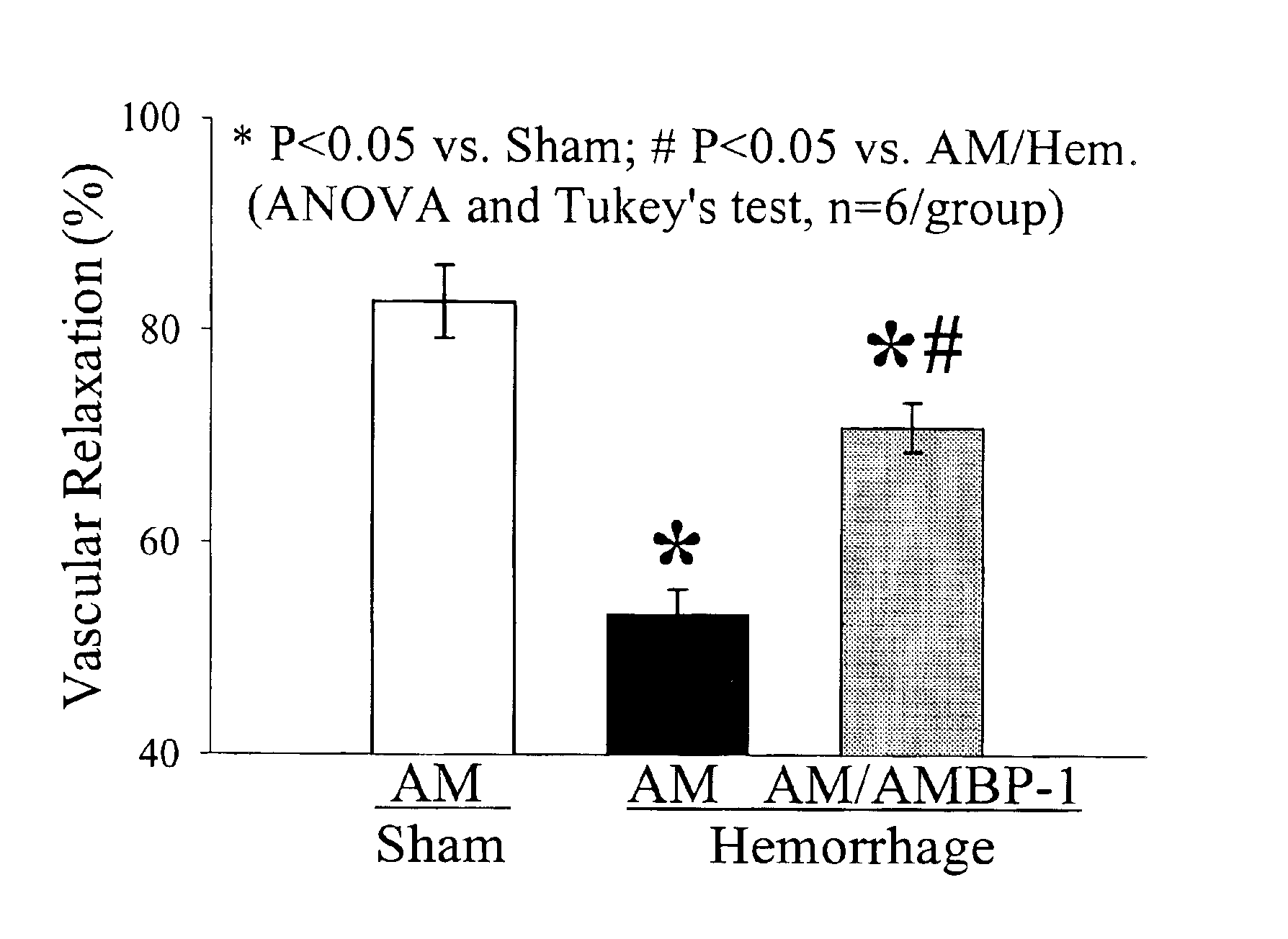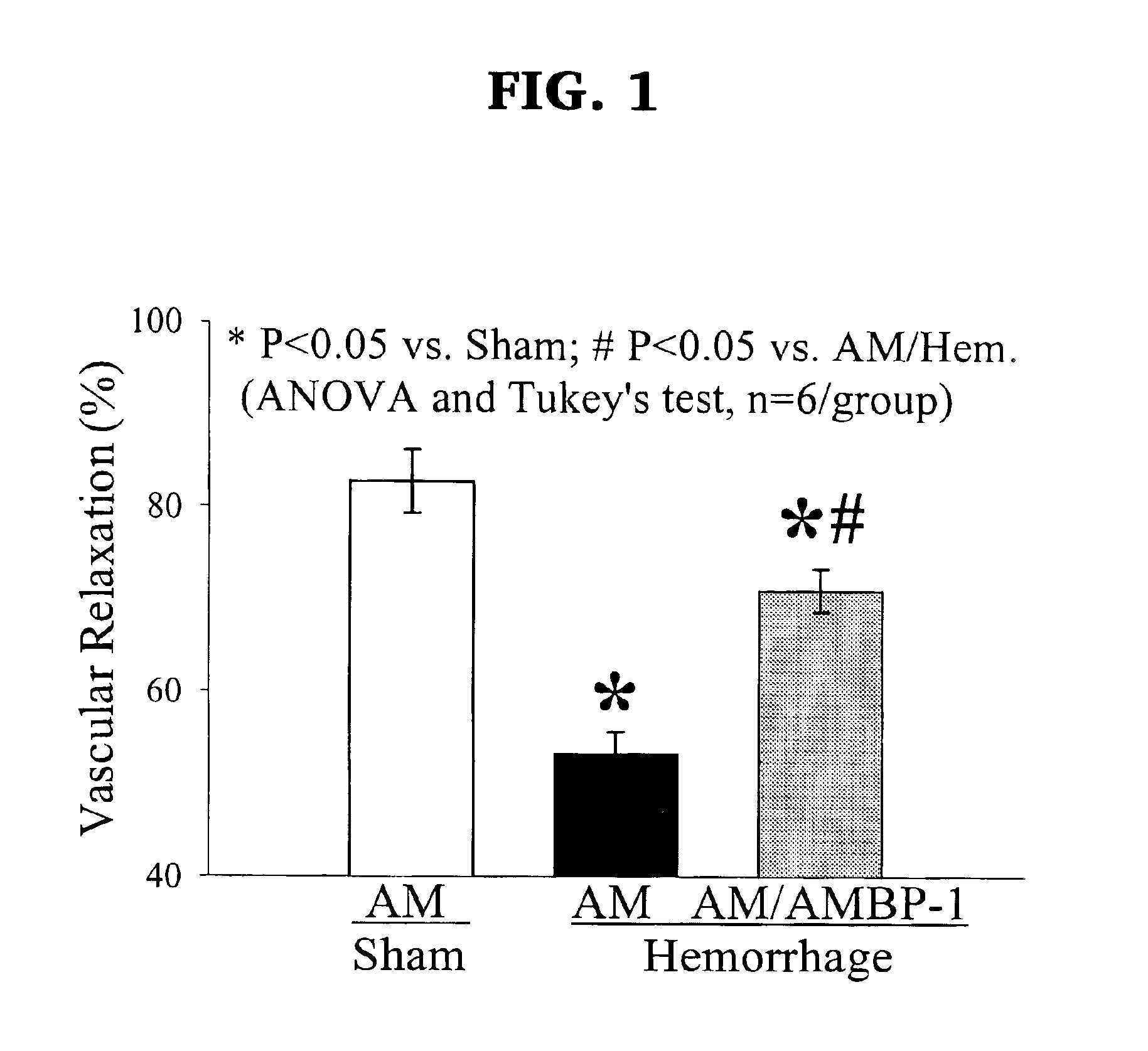Treatment of shock using adrenomedullin binding protein-1
a technology of adrenomedullin and binding protein, which is applied in the field of shock treatment, can solve the problems of difficult identification of one or two, and achieve the effects of preventing or treating a physiologic effect of shock in a mammal, and reducing the physiologic effect of shock
- Summary
- Abstract
- Description
- Claims
- Application Information
AI Technical Summary
Benefits of technology
Problems solved by technology
Method used
Image
Examples
example 1
[0041]It was observed in studies in rats that adrenomedullin (100 nM)+AMBP-1 (50 nM) reduced endotoxin (100 ng / ml)-stimulated release of TNF-α (Wu et al., 2003). This suggests that adrenomedullin is an anti-inflammatory factor. In the current study, the significant rise in serum levels of TNF-α, IL-1β and IL-6 seen at 20 h after the onset of sepsis in the vehicle-treated animals was significantly blunted in the animals treated with adrenomedullin+AMBP-1. In line with the beneficial effect of adrenomedullin+AMBP-1 on the cardiovascular response, it is probable that down-regulation of proinflammatory cytokines by adrenomedullin+AMBP-1 is one of the mechanisms responsible for the beneficial effects of these agents observed during sepsis. The plasma level of adrenomedullin was found to be reduced at 20 h after CLP in animals treated with adrenomedullin+AMBP-1 as compared with vehicle-treated animals. This apparently paradoxical result is explained by the fact that the available adrenome...
example 2
Modulation of Vascular Responsiveness to Adrenomedullin after Hemorrhagic Shock: Beneficial Effects of Adrenomedullin and Adrenomedullin Binding Protein-1 (AMBP-1).
[0065]Introduction. Our preliminary results indicate that vascular responsiveness to adrenomedullin is depressed after hemorrhage and resuscitation. Downregulation of AMBP-1 expression appears to be responsible for this hyporesponsiveness. In addition, AMBP-1 attenuates vascular adrenomedullin hyporesponsiveness induced by hemorrhage under in vivo conditions.
[0066]Hypothesis. Administration of adrenomedullin and AMBP-1 improves cardiovascular function after hemorrhagic shock under in vivo conditions.
[0067]Methods. Male rats (275-325 g) were bled to and maintained at a mean blood pressure of 40 mm Hg for 90 min. There were then resuscitated with four times the volume of shed blood in the form of Ringer's lactate over 60 min. At 15 min after the beginning of resuscitation in hemorrhaged animals, adrenomedullin (12 μg / kg bod...
example 3
Mechanisms Responsible for the Reduced Microvascular Responsiveness to Adrenomedullin after Hemorrhage: the Central Role of Adrenomedullin Binding Protein-1 (AMBP-1).
[0071]Irreversible hypovolemia remains a major clinical problem. Preliminary studies indicate that administration of adrenomedullin+AMBP-1 after hemorrhage improves cardiovascular function despite the increased levels of adrenomedullin. The aim of this study was to determine whether vascular responsiveness to adrenomedullin is reduced after hemorrhage and, if so, to elucidate the mechanism responsible for adrenomedullin hyporesponsiveness.
[0072]Methods. Male rats (275-325 g) were bled to and maintained at a BP of 40 mm Hg for 90 min. They were then resuscitated with 4 times the volume of shed blood in the form of Ringer's lactate over 60 min. At 1.5 h post-resuscitation (Rs), the vascular response to adrenomedullin (10−7 M) and AMBP-1 (2×10−8 M) was determined by using an isolated gut preparation. Blood and tissue sampl...
PUM
| Property | Measurement | Unit |
|---|---|---|
| volume | aaaaa | aaaaa |
| concentration | aaaaa | aaaaa |
| pressure | aaaaa | aaaaa |
Abstract
Description
Claims
Application Information
 Login to View More
Login to View More - R&D Engineer
- R&D Manager
- IP Professional
- Industry Leading Data Capabilities
- Powerful AI technology
- Patent DNA Extraction
Browse by: Latest US Patents, China's latest patents, Technical Efficacy Thesaurus, Application Domain, Technology Topic, Popular Technical Reports.
© 2024 PatSnap. All rights reserved.Legal|Privacy policy|Modern Slavery Act Transparency Statement|Sitemap|About US| Contact US: help@patsnap.com









